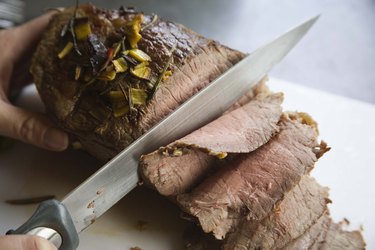How to Poach a Corned Beef Roast

When boiling beef, simmer the liquid rather than cooking at a total boil.
Image Credit: Rocketroom/Photolibrary/GettyImages
Boiled meat tin can make a tender and juicy stew or pot roast. Tough cuts of beef are tenderized through a slow cooking procedure using a small corporeality of liquid in a covered pot. Cooking with moist heat will not simply make meat tender but also increase the digestibility and bioavailability of nutrients.
Tip
When boiling beef, simmer the liquid rather than cooking at a total boil. Your meat will cook more than slowly and may accept longer, just volition be tender, tastier and retain more than nutrients.
Boiling a Roast to Tenderize
If y'all're using a budget-friendly cut of beef to fix a roast, cooking with moist heat is an constructive way to tenderize the meat. Connective tissue proteins, such as collagen and elastin, control the toughness of muscle tissue. They are broken downwardly and shrink from exposure to rut, according to an article published in Comprehensive Reviews in Nutrient Science and Food Safe in Jan 2018. This makes the meat easier to chew and digest.
Some cuts of beefiness that are appropriate for boiling and braising include the chuck, flank, shank, brisket, rump and round, co-ordinate to Certified Angus Beef. One of the most popular uses for boiled meat is for beef pot roast, which is usually made with added vegetables and cooked in a liquid containing spices, herbs, soy sauce or other flavorings.
Boiling as a method of cooking may not be suitable for ground meats because the fibers have already been broken down. Making a boiled meatloaf or boiled meatballs using this technique would likely produce less than desirable results.
A study published in the Asian-Australasian Periodical of Animal Sciences in February 2018 has found that humid meat reduced the fat content but retained more than wet than roasting meat. However, equally the temperature increased, boiled meat lost more weight and had an increase in saturated fats, while the total monounsaturated fatty acid content decreased.
Cooking Information technology Correct
The time required to tenderize beefiness by boiling depends on the size and weight of the piece of meat, in addition to the cooking temperature. A roast, such as a brisket or a shoulder, volition take longer than cutting-up pieces of stewing meat.
To eddy a roast, cooking it slowly is the key to a fork-tender result. A medium-sized 6-pound roast will take about four hours. Here are some suggestions for your adjacent Sun pot roast:
- Put a small-scale amount of water in the bottom of a large pot. To tender the meat, add together an acrid to the cooking water, such as a splash of lemon juice, some chopped tomatoes or Worcheshire sauce.
- Place the roast in the pot along with some crushed garlic. Sprinkle with salt, pepper and whatsoever spices of your choosing, such as thyme or rosemary. Cover the pot with a lid.
- Heat on the stovetop until the water is simply simmering. Exercise non cook at a full boil. Try not to allow the temperature of the liquid exceed 195 degrees Fahrenheit because the humid temperature of water — 212 degrees Fahrenheit — toughens meat protein, warns the American Meat Science Association.
- As the meat cooks, you may need to add more water. You'll know it's cooked to a safe temperature when your thermometer reads 145 degrees Fahrenheit, according to the USDA'due south food safety recommendations.
- When the meat has finished cooking, permit it residue for at least three minutes before slicing. Use the liquid for a sauce or gravy to regain some nutrients from the dissolved water-soluble vitamins.
Does Boiled Meat Lose Nutrients?
All cuts of beef incorporate like amounts of macronutrients. According to the USDA, a beefiness pot roast provides about 98 calories per slice (63 grams). Rich in protein, beef offers 18.three grams per slice without any carbs, fiber or sugar. The total fat content is 2.7 grams, including 1 gram of saturated fatty acids.
Meat contains all the essential amino acids that your body needs for energy. Amino acids make up the protein needed to build, maintain and repair your tissues. Each serving of beef provides numerous minerals and vitamins. As per the USDA, some of the most important nutrients include:
-
Iron – 1.8 milligrams
-
Phosphorus – 112 milligrams
-
Zinc – 2.8 milligrams
-
Selenium – 17 milligrams
-
Vitamin B12 – 0.77 micrograms
-
Thiamin – 0.02 milligrams
-
Riboflavin – 0.2 milligrams
-
Niacin – two.half dozen milligrams
-
Vitamin B6 – 0.2 milligrams
-
Sodium
–
251 milligrams
-
Potassium
–
134 milligrams
-
Magnesium
–
6.iii milligrams
Cooking time and temperature play an of import role in the final characteristics of meat. Cooking doesn't significantly alter the protein value of meat unless you lot use a loftier temperature for a long period of time. Doing and then tin slightly decrease the poly peptide's biological value, according to the American Meat Science Association (AMSA).
By boiling beef in liquid, some nutrients may be reduced. According to the Comprehensive Reviews in Food Science and Food Safe report, 100 percent of thiamin is lost in beef brisket boiled at 212 degrees Fahrenheit. AMSA says that meat cooked at lower internal temperatures ordinarily retains more thiamin than meat cooked at higher temperatures.
Additionally, 84 percent of the B-vitamins riboflavin and niacin are lost by boiling meat, reports _Comprehensive Reviews in Nutrient Science and Food Safet_y. Boiling beef affects the mineral content by decreasing sodium, potassium, phosphorus and magnesium while increasing the levels of iron and zinc.
engstromboser1997.blogspot.com
Source: https://www.livestrong.com/article/501816-how-to-boil-beef-to-make-it-tender/
0 Response to "How to Poach a Corned Beef Roast"
Post a Comment